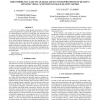Free Online Productivity Tools
i2Speak
i2Symbol
i2OCR
iTex2Img
iWeb2Print
iWeb2Shot
i2Type
iPdf2Split
iPdf2Merge
i2Bopomofo
i2Arabic
i2Style
i2Image
i2PDF
iLatex2Rtf
Sci2ools
ICIP
2007
IEEE
2007
IEEE
Does where you Gaze on an Image Affect your Perception of Quality? Applying Visual Attention to Image Quality Metric
The aim of an objective image quality assessment is to find an automatic algorithm that evaluates the quality of pictures or video as a human observer would do. To reach this goal, researchers try to simulate the Human Visual System (HVS). Visual attention is a main feature of the HVS, but few studies have been done on using it in image quality assessment. In this work, we investigate the use of the visual attention information in their final pooling step. The rationale of this choice is that an artefact is likely more annoying in a salient region than in other areas. To shed light on this point, a quality assessment campaign has been conducted during which eye movements have been recorded. The results show that applying the visual attention to image quality assessment is not trivial, even with the ground truth.
ICIP 2007 | Image Processing | Image Quality Assessment | Objective Image Quality | Visual Attention |
| Added | 16 Aug 2010 |
| Updated | 16 Aug 2010 |
| Type | Conference |
| Year | 2007 |
| Where | ICIP |
| Authors | Alexandre Ninassi, Olivier Le Meur, Patrick Le Callet, Dominique Barba |
Comments (0)

